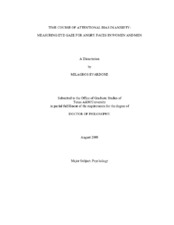| dc.description.abstract | The time-course of the attentional bias to threat in women and men was examined in order to clarify the validity of the "vigilant-avoidant hypothesis" and extend findings with spider pictures (Rinck and Becker, 2006) to other ecologically valid stimuli. Two hundred thirty-one (104 men, 127 women) participants pre-selected for high and low trait anxiety completed a battery of mood measures and viewed a series of slides with competing angry versus friendly faces. For a subset of these participants (54 men, 50 women), fixations and gaze durations were recorded via an eye tracker. All participants completed a face recognition task and provided copy and live measures of digit ratio (2D:4D), a putative marker of prenatal androgen exposure. Consistent with results from Rinck and Becker (2006), it was predicted that highly anxious individuals would show a vigilant-avoidant pattern toward angry faces while lesser anxious individuals would attend equally to angry and friendly faces over time. In addition, it was hypothesized that the vigilant-avoidant pattern would be stronger in highly anxious women. For secondary hypotheses, it was expected that digit ratio would correlate positively with trait anxiety and that attentional patterns for threat would differ between those with low and high digit ratio.
Results did not support a heightened threat bias in high anxious versus low anxious individuals. Both groups showed an early bias for the angry female face during the first 1500 ms of presentation and a general avoidance for the angry male face over the course of 60 s. Although no association was found between trait anxiety and digit ratio, there was a negative correlation between reports of obsessive-compulsive symptoms and live left hand digit ratio in men. Moreover, early attentional patterns for angry faces appeared to differ between women with low and high digit ratio, suggesting that prenatal androgen action may lead to cognitive biases associated with the development and maintenance of anxiety. | en |


